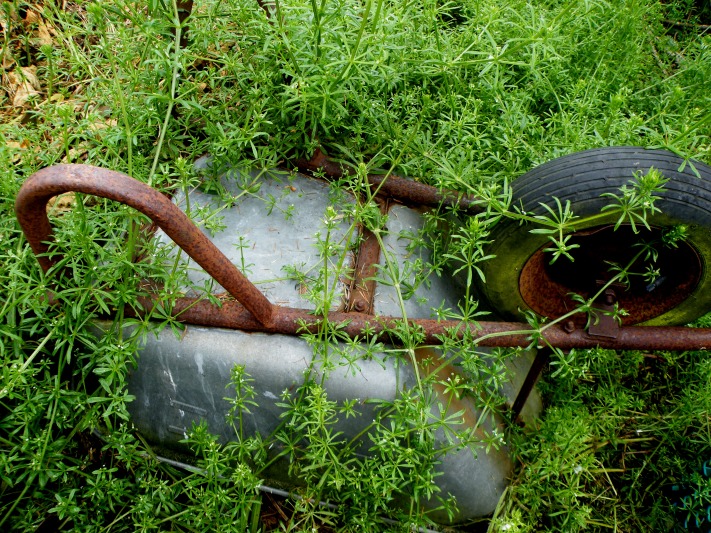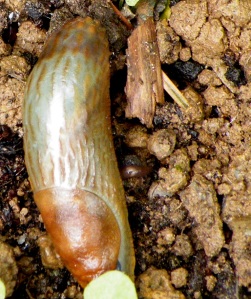Two weeks ago I used this wheelbarrow. Today I found it totally overgrown with cleavers, or goosegrass like we call it. And so it is with quite a few other areas of the garden. During the last week or two growth has been fierce due to weather conditions, it has been very damp with temperatures between 15 and 17 degrees.
Last year I started to try and apply permaculture principles in the garden. My main reason was that I am very interested in foraging, in wild plants. I noticed that these plants, such as dandelions, nettles, or goosegrass would grow really well, while some vegetables were having difficulties. I thought that maybe mixing them all, letting them grow together so to say, would help keep pests at bay. So I read up on permaculture and found that it is all about getting a balance in the garden, or rather getting the ecosystem balanced. Therefore when during the early months of this year the dandelions started to grow well, I used a lot of them in our foods, same with nettles, and even goosegrass. But then I made a mistake, for which I am now paying, I let all these wild plants grow without disturbing them at all. The goosegrass has totally taken over, I guess I did not use enough of it. I now realise that I should have kept the upper hand and at least tamed the wild plants a little.
So today I made a start at clearing.
The other motivation to clearing up around the raised beds is the problem with the slugs and snails. Everyday now I gather them, but the supply keeps coming, and my plants are being attacked and eaten faster than I can replant them. This morning I discovered two mature broccoli plants, and one kale plant with leaves full of holes. In desperation I started to cut the hedges around the raised beds, and cleared away any leaves lying around, sure enough I filled a jar with the culprits in no time.
I went and googled permaculture and slug control and learnt a lot. It said in the article that it was no good transporting the slugs to another area, this only un-balances that ecosystem there, so I got to stop doing that. It gave quite a few good ideas to deal with this plague, one I liked is the use of beer, and tomorrow I will purchase a six pack and hope to have a lot of drunken slugs! Not sure which type of beer to use though 🙂 so will get the light beers I think. Some of the other options mentioned in the article, such as frogs, hedgehogs, nematodes, toads, or ducks etc… did not appeal to me, one other option though I liked, it is the encouragement of the carob beetle, a predator of slugs. It explained how to build a nest for these creatures, something I might try out at some stage as I quite like beetles.
One of the principles of permaculture is that one should just observe the garden, see what goes on, and take note. I do that on a daily basis and have found that the beds that have herbs, such as oregano, lemon balm, rosemary, calendula, sage, and mint growing in them, have much less damage from said slugs and snails. There is also one type of lettuce that survives every time, so that is the one that I should definitely sow next time round. The broad beans remain untouched, they are also growing on the bed with garlic.
Its a learning curve, exciting and challenging – it can be very discouraging when so much of what you sow or plant gets eaten, but there has got to be a way around it. I am sure to be getting on top of this particular problem.
Goosegrass taking over part of the garden!
Snail and slug, two culprits which while I love them, I must rebalance the eco system of my garden.
Some of the damage in the above photos, damage of mature plants!
The type of lettuce the slugs don’t touch. And around the beds clearing up is being done seriously now!











I’ve got huge slugs here and they came in accidentally with some “composted” manure from the east side of my county where the soils are clay and a bit calcareous. So far they just live around the house and only a few have ventured beyond (slow movers I guess). I hunt for their eggs and destroy those and for the adult slugs in traps (boards on wet soil) and kill them too (it’s cruel, I know). I also use a bait made from iron phosphate, relatively safe, which kills them if they eat it.
LikeLiked by 1 person
Sounds all good! I am going to get beer now tomorrow and use that as bait! They will die happy I hope.
LikeLiked by 1 person
Slugs and snails are a real problem this year. I think permaculture is great but I do think it’s principles have been put together by people who don’t live with the populations of slugs we have here in Ireland! There is an organic slug defense gel I have been using. It’s not cheap but good for protecting those precious plants you want. The gel is suppose to act like a barrier. I use organic slug pellets too – though as little as I can get away with. I prefer to use them in beds where I know the birds can’t get too (even though they are supposed to be harmless to birds) – so i put them in beds I have netting over. Have just tried putting a few under a flower pot in a bed I have some seedlings coming. I’ve been known to collect both slugs and snails and feed them to our ducks too and in the winter the ducks overwinter in the veg plot and probably do a lot of good!
LikeLiked by 1 person
Thank you so much, that is very helpful. Yes, it seems that this year is particularly bad with the slugs. I collected over three dozen today! Will put out beer tomorrow too. What is the gel called you talk about? It would probably be a good thing to try out. It’s been so wet around here and of course slugs love that, also my soil, which is a topsoil we bought is clay, but we have improved it a good bit already and working on it.
Thanks again.
LikeLiked by 1 person
It’s called Slug Defence Gel (organic) and it’s made by Doff.
LikeLiked by 1 person
Many thanks, will check at garden centre today. 🙂 Heavy rain and high winds here today! Not a gardening day I think.
LikeLiked by 1 person
I will be following to see how your permaculture works out.
LikeLiked by 1 person
Thank you, yes – me too – only this morning my partner and I had a long conversation about it, it is such a learning curve, and I’ve had to adjust plans and ways already a few times. It is a challenge and that is exactly what I enjoy, that and the delight of working with nature 🙂
LikeLiked by 1 person
Ducks love to eat bugs but only one problem–they eat the produce, too! 🙂 Good luck with your pest issues!!!
LikeLiked by 1 person
Haha, you are right Lori! But down the line maybe I might try some ducks, right now I cannot go there as there are fox here that would love a duck meal, so first make a proper duck house 🙂
LikeLiked by 1 person
Good luck!!!
LikeLiked by 1 person
Thank you Lori 🙂
LikeLike
Sounds like you are learning a lot, even if at the moment you are facing a struggle with our slimy friends. To be honest, it seems that the dampness will be what attracts them to your raised beds and more vegetation will increase that. So good luck with the beer etc.
LikeLiked by 1 person
🙂
LikeLike
Very much appreciated, thank you.
LikeLike
I do pay a lot of attention – but for the most part, it all seems a mystery. I am like you: when I DO see a positive connection ( rosemary gave me great cabbages); I will remember it. We’ll see if it is truly a connection that always works, or one that’s based on the weather that year, or if it’s all purely my imagination!
LikeLiked by 1 person
Yes likewise. In my planning for next year I will arrange the beds that way that the herbs, like in your case rosemary, are on every bed. It’s all fascinating isn’t it.
LikeLike
It really IS fascinating – like a lifelong science project.
LikeLiked by 1 person
🙂 🙂 🙂 yes indeed!
LikeLiked by 1 person